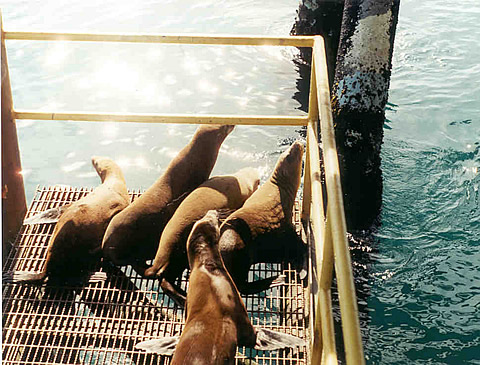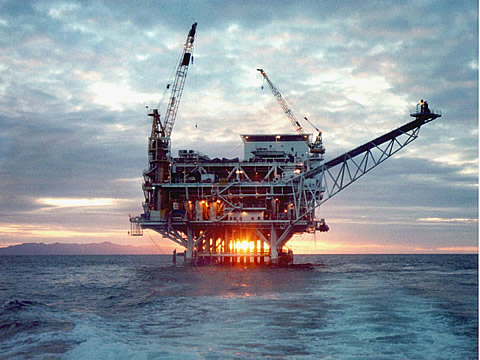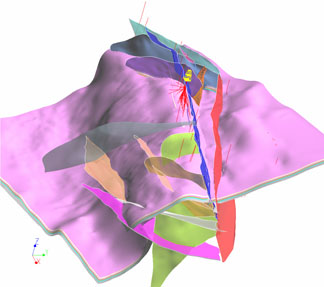Due to the tectonic history of the Santa Barbara channel, the geology of the Monterey shale is very complex. As of May 2006, the Monterey formation at South Ellwood field had produced 57.5 million barrels of oil, 49.4 billion cubic feet of gas, and 63 million barrels of water. This represents only about 5% of original-oil-in-place. Total resources in-place field-wide are estimated at over 1 billion barrels of oil. High water cuts across the field had rapidly deteriorated the economics. Substantial additional recovery of remaining oil-in-place in the project area (up to 50 million barrels of oil) can be realized if fracture patterns can be characterized and aquifer movement within the fracture conduits can be managed.
Well productivity in South Ellwood field varies significantly and is primarily affected by the position of the well path with respect to macro- and micro-faulting and fracturing in the Monterey reservoir, the resulting heterogeneity, and the degree of aquifer support. To redevelop the field and optimize reservoir management, Venoco and USC have mapped and characterized the field-wide fracture patterns and the reservoir conduit system.
Protection of the local marine mammal population of the Santa Barbara Channel makes it very difficult to shoot conventional seismic surveys in the South Ellwood field. Other techniques must be used to identify new reserves in the complex, faulted Monterey formation. South Ellwood field currently operates from a single offshore platform, Holly, with 30 well slots used for high angle wells drilled into the 1,000 foot thick Monterey fractured chert.
The former operator, ARCO Western, had built two cement pyramid-shaped collecting tents over natural gas seeps in the Santa Barbara Channel. Venoco maintains the seep tents and produces 350,000 cubic feet of gas per day from them.
Results
The project has used advanced technologies to reprocess 20-year-old 3-D seismic data, resulting in the identification of four previously unknown fault block targets containing over 80 million barrels of potential oil reserves. New technologies have been applied to reduce the water cut and to position new high angle wells, resulting in an estimated nine million barrels of incremental oil recovery by March 2006. South Ellwood field production rose to 3,800 barrels per day by June 2006.
Benefits
The first new development well positioned using reprocessed seismic and lithologic data came in at 800 barrels of oil per day and paid for itself in only a few months. Estimated ultimate recovery for this well is more than three million barrels.
In one well, the use of the Thru-tubing plug-back technology reduced the water-oil ratio from five times the amount of oil to nearly equal volumes of water and oil. The cost of the Thru-tubing plug back pays for itself in 20 days of production at South Ellwood field, and has significant potential for other high water-cut oil fields. The initial $230,000 investment added 6 million barrels of production ($300 million with crude oil at $50/bbl).
Reprocessed 1982 seismic data was used to locate well paths for drilling the South Ellwood lease and identified four previously unknown fault block targets with over 80 million barrels of potential reserves. The Pipeline Network Fracture Simulation Model and algorithm released to the public provides a valuable tool for analysis of fractured reservoir characteristics.
The impact of removing the natural gas using the seep tents has reduced air pollution in the Santa Barbara Channel area and resulted in a favorable impression of offshore production in California.
Project Summary
Researchers have:
- Reprocessed 1982 3-D seismic survey data using modern algorithms.
- Mapped Eagle Canyon, North Flank, Middle Sespe, and Monterey Subthrust prospects (90 million barrels of possible new oil reserves).
- Run new-generation production logs to identify oil/water contacts in six wells.
- Conducted Thru-tubing plug-backs in five wells for a 600 barrel-per-day gain in oil output and 6 million barrels of reserve additions.
- Constructed a new simulation model using reprocessed seismic, production data, dipmeter, BHTV, FMI, and oriented core data.
- Drilled three new wells: 3120-15RD4 tested 35° gravity oil from the Middle Sespe, 3120-18 tested the North Flank prospect, and 3242-7RD2 is producing 950 barrels of oil per day and 1.7 million cubic feet per day of gas from the Eastern margin of the field.
Environmental issues at South Ellwood field are of intense concern, because of the marine mammal population and the naturally occurring gas seeps. The seep gas collection tents have proven to be an important component of improved water quality. Collection of the gas is credited with lowering the reactive hydrocarbon emissions in the area and decreasing the surface oil seepage, resulting in cleaner beaches and surface waters in the Santa Barbara Channel. Advances in drilling high angle wells from a single offshore operating platform have reduced the visual impact of oil development. The Thru-tubing plug-back technology has achieved a significant reduction of produced water brought to the surface. This means significantly lower volumes of water are transported onshore for processing and disposal.






